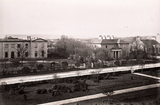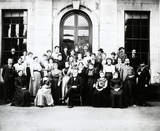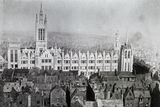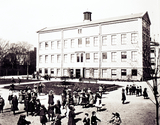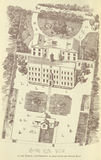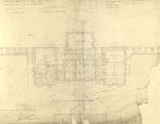|
Quick Search
|
Search Results
You searched for: More Like: 'The story of Albyn School for Girls, pt. 1'...
31 items
items as
Albyn Place
24 Albyn Place leading west to Queens Road. Aberdeen High School for Girls, designed by Archibald Simpson as Mrs Elmslie's Institution (1837-39) is on the left of the picture. c.1880 The staff of Aberdeen High School for Girls
455 The staff of Aberdeen High School for Girls outside the main entrance of the school on Albyn Place. The building was designed by Archibald Simpson. Stop 1: Marion Douglas, Lady Drum (1577-1633) and Katherine Forbes, Lady Rothiemay (1583-1652), The Town House
2300 On the ground floor of the Town House on each side of the walls hang the mortification boards. These boards form a public record of the mortifications or legacies given by wealthy citizens to Aberdeen Town Council for various charitable purposes. Many of the donors are women and two are of particular interest - Lady Drum and Lady Rothiemay. They were early philanthropists, aware of older women and girls living in circumstances locally much less favourable than themselves.
Lady Drum left money to provide a home for poor widows and aged virgins. This home known as "Lady Drum's Hospital" was built c1677 in what became known as Drum's Lane, just off Upperkirkgate and today a plaque marks its site. Lady Rothiemay had a turbulent life. Her husband and son were killed in a feud with a neighbouring family and she attempted to avenge their deaths. She was imprisoned in Edinburgh. Once released she lived in Aberdeen and founded Lady Rothiemay's School for Girls, in which she took a personal interest. The school moved several times, from Guestrow finally to Littlejohn Street. It was closed in 1873 when School Boards were set up to oversee primary education for the under twelves, following the Education Act of 1872
Stop 11: Early Health Services at Aberdeen General Dispensary, Vaccine and Lying-in Institution, 1823
2310 We have to use our imagination a little as the street known affectionately by locals as the 'Gushie' no longer exists other than Provost Skene's House which has the address of 45 Guestrow. In 1823 The General Dispensary, Vaccine and Lying-In Hospital opened in Guestrow, a street that ran parallel to Broad Street from where approximately the Illicit Still is today to where it joined Upperkirkgate.
The General Dispensary, Vaccine and Lying-in Hospital gave free medical advice and treatment to all that required it. These early health services were provided for poorer families often living in the East End of Aberdeen who couldn't afford to pay for medicine, vaccines or to see a doctor. Although a team of doctors were employed at the Institution, young medical students from across the road here at Marischal College also undertook some of their training at the Institution.
The Lying-In part of the Hospital was for women who, once they had had their babies, would 'lie in' for a few weeks as they had such poor living conditions at home. In 1880 it was recorded that 3327 cases were dealt with in that one year alone. It wasn't until 1892 that midwives were employed, recognizing the need for specialist nursing care for pregnant women. This greatly improved the nursing care provided and understanding of the specific needs of mothers and babies.
A famous daughter of Aberdeen who has shaped midwifery throughout the world is Maggie Myles (1892-1988) who wrote her groundbreaking book Textbook for Midwives 'With Modern Concepts of Obstetrics and Neo-natal Care' in 1953, the year before she retired. Maggie produced a further nine editions, each kept up-to-date with the latest developments and best practice. The book has been translated into many languages and is recognized as the leading international textbook for midwives. The book is now in its 15th edition. Born in 1892 in Aberdeen the daughter of a housepainter and former domestic servant Maggie Myles life story is truly remarkable. Migrating to Canada soon after leaving school Maggie would rise to become the director of midwifery education in Philadelphia and Detroit before returning to Scotland in 1939 to be Midwifery Tutor at Simpson Memorial Maternity Pavilion in Edinburgh.
Memories:
Heather's memories of Billie Maver and the General Dispensary
Nora recounts her memories of Maggie Myles
Edith shares her memories of Maggie Myles Aberdeen High School for Girls
2395 A photograph of the Aberdeen High School for Girls on Albyn Place taken from the school's 1896-97 prospectus. John M'Bain was the headmaster of the school at the time. Aberdeen High School for Girls
2402 This photograph dating from the early 1900s, shows pupils in the playground at the rear of the High School after the large extension to the original building had been constructed. Aberdeen High School for Girls
262 A bird's eye view illustration of the Aberdeen High School for Girls. Albyn Place is visible at the top of the image. Taken from the 1893-94 school prospectus. Treasure 69: Mrs Elmslie's Institution Plans by Archibald Simpson, 1837
269 Mrs Elmslie was one of a number of Victorian philanthropic benefactors sympathetic to the plight of those who were poor, neglected or homeless and on 19 November 1840, she opened the Aberdeen Female Orphan Asylum - known also as Mrs Elmslie's Institution - on 19 Albyn Place.
This lithograph shows the building as originally envisaged by architect Archibald Simpson with little gate-houses at either side of the street entrance. Aberdeen City Libraries hold a series of 14 plans of the granite building which have been bound together into a single volume. The collection includes elevations, sections and floor plans dated September 1837.
The Orphan Asylum closed its doors on 27 July 1891 and the remaining girls were transferred to the Girls' Home and School of Domestic Economy on King Street. The building was sold to the Aberdeen School Board for £4,500 and, after extensive additions and refurbishment, it became the new home of Aberdeen High School for Girls, renamed as Harlaw Academy in 1970.
Find out more about Mrs Elmslie and her Institution, including its rules and regulations, daily meals and class timetables, in the Treasures from our Collections exhibition on touchscreens in Central, Airyhall, Tillydrone and Mastrick libraries. |



